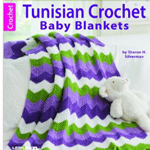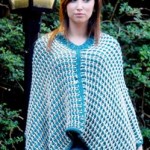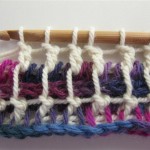Ah yes, the book tour, in which the author visits dozens of exciting cities, gives talks to adoring fans, has a publicist to take care of all logistics, has all travel expenses paid for by the publisher, and signs record numbers of books. Right? Not exactly, at least not for the authors of crochet titles. Although I'm not on tour myself, my book is enjoying an exciting journey to crochet bloggers all over the country. I'm honored that Tunisian Crochet Baby Blankets has made it into the blogs of these movers and shakers in the crochet world. Here's some of what they have had to say about the book. Read the full reviews at the links shown (remember that some of the giveaways may be finished by now):
I absolutely love this book! I think that the patterns are all timeless baby patterns, and would work in a variety of colors, not just the ones shown. Each pattern has photo help to help you understand each special stitch given, so you aren’t hunting on YouTube for video how to! Patterns are easy to read and the designs are just gorgeous. I wish I had this book when I was working on blankets for my 2 new great nephews earlier this year!--Karen Whooley, KarenWhooley.com
And from Tammy Hildebrand, VP of the CGOA:
If you haven't seen Sharon Silverman's new book yet, you're in for a treat! Eight beautiful Tunisian baby blankets including cables, ripples, stripes, bobbles and basket weave. There are four "easy" designs, three "intermediate" and one "intermediate plus". There is truly something for everyone. And what's really great is that there are also online technique videos available to help should you need them. -- Hot Lava Crochet
Here's what Eurona posted on her blog:
Another pleasant surprise in Tunisian Crochet Baby Blankets is a jaw-dropping stranded colorwork pattern for those of us who would like to take our stitching skills to the next level. --Hands in Delight
Kathryn Vercillo had this to say:
I was familiar with the basic look of Tunisian crochet before this but had no idea that it could be used to make such a variety of different patterns including popular crochet stitch patterns like the basketweave stitch. Bobbles, cables and ripples are also all included in these patterns, each with a slightly different look from their traditional appearance since they are done in Tunisian crochet. What a great unique gift for the baby who already has a lot of handcrafted items from others!--Crochet Concupiscence
No less a luminary than Gwen Blakley Kinsler, founder of the Crochet Guild of America, reviewed the book on her blog:
I love Tunisian crochet and I’ve been doing a lot of it lately. This beautiful book by Sharon Silverman gives me a few more items to put on my “to-do” list!--Crochet Queen
Marty Miller, Past President of CGOA and one of my inspirations--I took her class at the first crochet show I attended in Valley Forge, PA--did a thorough review. Here's some of her evaluation:
Sharon is one of the "stars" of Tunisian Crochet, and her newest book certainly shows that. Eight baby afghans, each one a different Tunisian technique, each one a different Tunisian stitch or combination of stitches....Then, this week, I brought the swatches to class, and showed my students. They all liked the Tunisian stitches with the variegated yarn better than the regular crochet stitches with variegated yarn. And then, I showed them the other afghans in the book – they all oohed and aahed over them, but the two afghans that they were really interested in crocheting were the ripple afghan on the cover, and the Tunisian Full Stitch afghan - Purple Garden.--Not Your Granny's Crochet
Here is the evaluation posted by Karen McKenna, I Hook Design. Karen also swatched several of the projects and includes pictures of her projects:
This has been a great experience expanding my crochet skills, who says you can't learn new techniques. Thanks Sharon and Leisure Arts for making it easy....
I highly recommend this book for beginners and experienced as well. What I love about the blankets is if you make them a little larger they are all perfect as a throw for yourself.--I Hook Design
And just today, Jocelyn Sass from Cute Crochet Chat/Crochet Cafe posted her interview with me. She asked me how I got familiar with Tunisian:
I discovered Tunisian crochet in a stitch dictionary while I was designing projects for my first crochet title, Basic Crocheting: All the Skills and Tools You Need to Get Started. I learned the basics from that book, then sought out other sources to extend my knowledge of the technique. It was really exciting to see the fabric that Tunisian crochet creates. I never liked projects with rivers of double crochet stitches—too loopy!—and Tunisian had a totally different look.--Cute Crochet Chat
If you aren't regular readers of these blogs, I urge you to become one. It is refreshing to find thoughtful, experienced crocheters who share their experience so eloquently and generously.
More blog book tour stops are coming up later this month. Please check back here and on my Facebook page, Sharon Silverman Crochet, for information about those reviews and giveaways.
Maybe it's a good thing I'm not on the road myself. With the snow we've had this winter, I might not have been able to make it out of here!






